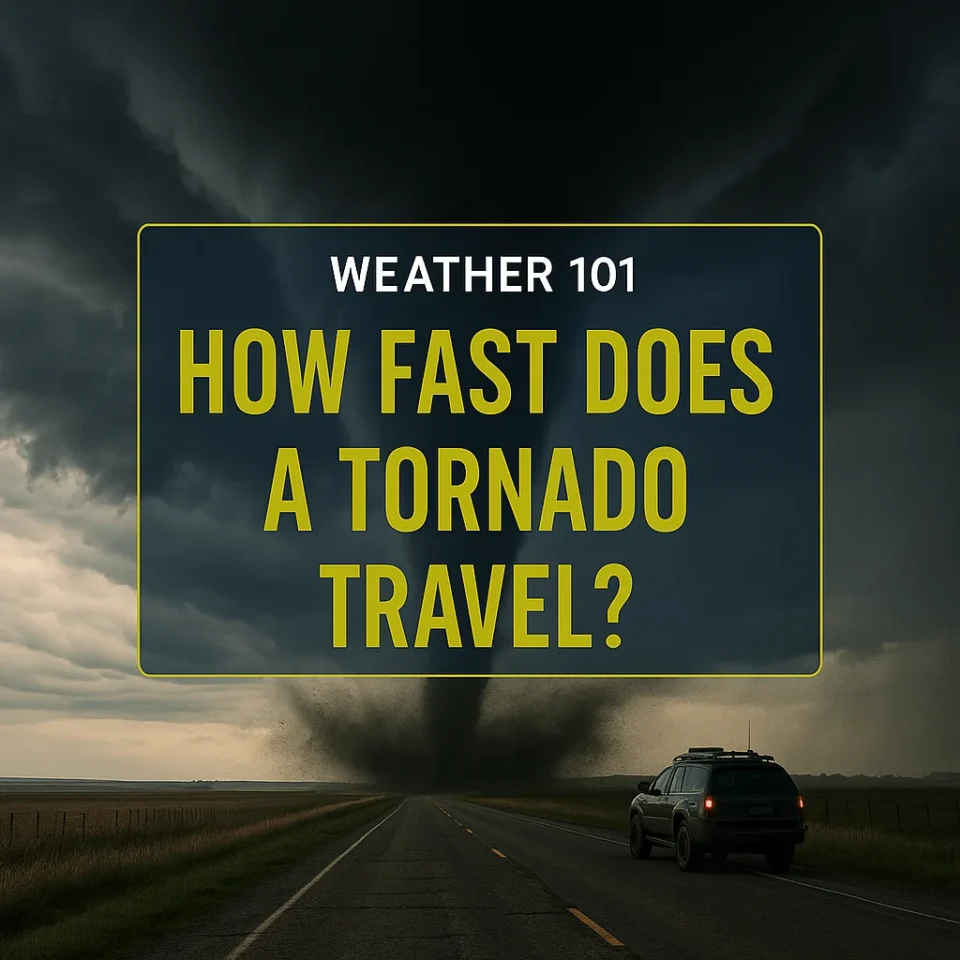How Fast Does a Tornado Travel?

Tornadoes don’t wait. One moment, all is calm. The sky is gray, and the air is thick. Then, suddenly, a swirling column of wind cuts across the land. But how fast do tornadoes move? What does their speed mean for people in their path?
Understanding tornado speeds is crucial. It helps communities respond quickly. Emergency teams gain valuable time. It can save lives when every second counts. Let’s dive into this topic. We’ll look at tornado speeds and share real examples from Palatine, Illinois, and Fairfield, Ohio.
So, How Fast Do Tornadoes Move on the Ground?
Tornadoes are hard to predict for speed. They usually spin at 30 to 50 miles per hour. Some move slowly at only 10 mph. Others can race at 70 mph or more! This speed refers to how fast they travel over land. It doesn’t count the strong winds inside the funnel, which can top 200 mph in severe storms.
Travel back to the Tri-State Tornado of 1925, a fierce storm. This tornado ripped through Missouri, Illinois, and Indiana at 73 mph. Its path covered over 200 miles, causing massive destruction. It still holds the title of the fastest tornado in U.S. history.
Tornado in Fairfield, Ohio: A Local Example
In Fairfield, Ohio, tornadoes tell stories that stick in your mind. Over the years, storms have swept through like quick shadows. They may not have broken speed records, but they surprised residents. Each gust and swirling cloud reminded everyone of nature’s strength.
Tornadoes are tricky. Their speed means more than just destruction; it also affects reaction time. A tornado at 50 mph can reach your doorstep in just minutes. The faster it moves, the more urgent the warning must be.
What Controls How Fast a Tornado Moves?
Several things influence a tornado’s speed:
- The parent storm: Tornadoes form within bigger thunderstorms. If that system is moving quickly, chances are the tornado will be too.
- Wind shear: This is the change in wind speed and direction with height. Strong wind shear can make tornadoes more intense and move faster.
- Terrain: Open land allows tornadoes to keep their momentum. But if a tornado runs into hills, forests, or urban areas, it might slow down—or shift direction.
- Larger weather systems: Jet streams, cold fronts, and pressure systems can all affect how quickly storms travel.
So, how do tornadoes travel? Think of them like passengers in a bigger vehicle—the thunderstorm is the driver. The tornado follows wherever the larger system takes it.
Are There Going to Be Tornadoes Today?
Do you live in tornado-prone states like Oklahoma, Illinois, or Ohio? If so, you probably think about this every spring or summer. It’s a smart question to ask. Checking your local forecast can make a big difference. Agencies like NOAA and your weather app can alert you when conditions are right for tornadoes.
Tornadoes usually form from supercell thunderstorms. These storms can also cause hail, lightning, and heavy rain. Stay alert for rotating clouds, storm watches, or warning sirens in your area.
How Fast Do Storms Move Compared to Tornadoes?
Sometimes, the storm that creates a tornado can move faster or slower than the tornado. Tornadoes can gust at 40 mph on the ground. Meanwhile, their storm can move at 60 mph or more. This is particularly true in fast upper air pattern scenarios.
Knowing storm speeds helps people prepare for more than just tornadoes. Flash floods and hail can strike suddenly during fast-moving storms. High winds and lightning are also possible.
Forget “100 Facts About Tornadoes”—Here’s the One That Matters
You’ll find plenty of websites listing 100 facts about tornadoes, but here’s one you should remember: speed matters.
The faster a tornado moves, the less time you have to get to safety. Towns that invest in emergency sirens, weather alert systems, and storm shelters are better protected. The earlier the warning, the more lives can be saved.
Why Travelers Should Care About Tornado Speeds
If you’re driving through tornado country—especially in spring—it pays to know the risks. Tornadoes can move as fast as a car on the highway. If you’re caught on the road with one nearby, outrunning it isn’t always an option.
That’s why at The Travelers Diaries, we encourage all travelers to check the weather before heading out. Whether your road-tripping through Kansas or camping in Illinois, weather awareness is part of smart planning. Stay safe. Stay informed. And never underestimate a fast-moving storm.
Conclusion: The Importance of Tornado Speed
Tornadoes don’t always give you much time. Whether it’s the Palatine tornado in Illinois or a surprise twister in Fairfield, Ohio, these storms can arrive quickly and hit hard. Knowing how fast a tornado moves, along with understanding the bigger storm around it can help you act faster and smarter.
So next time the forecast looks rough, ask yourself: Are there going to be tornadoes today? Take a moment to check the radar, listen to alerts, and have a plan.
And if you’re traveling, let The Travelers Diaries be your weather-smart companion. Because when it comes to tornadoes, the more you know, the faster you can respond.
FAQs
Q: Do tornadoes follow roads or city layouts?
A: No. Tornadoes travel based on wind patterns, not man-made structures. They move wherever the storm system takes them—roads don’t guide them.
Q: Was the Palatine tornado one of the fastest?
A: Not the fastest, but it was fast enough to cause surprise and damage. Its sudden arrival made it especially dangerous.
Q: How fast do most storms move?
A: Storms usually travel between 20 to 60 mph. Supercells and strong fronts can push that number even higher.
Q: Can tornadoes change direction while traveling?
A: Yes, especially if the larger storm system shifts. That unpredictability is what makes tornadoes so dangerous.



